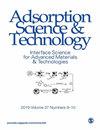壳聚糖/膨润土复合材料去除Cr (VI)的制备与表征
IF 3.2
4区 工程技术
Q2 CHEMISTRY, APPLIED
引用次数: 5
摘要
采用物理胶凝法制备壳聚糖/膨润土复合材料(CSBT),对其吸附Cr (VI)的性能进行了研究。以2:1和1:2的质量比制备复合材料,发现1:1的复合材料最适合高效去除Cr (VI)。采用响应面法(RSM)对温度、吸附剂剂量和pH对Cr (VI)的去除率进行了统计优化,发现pH是吸附过程中的限制因素,在吸附剂剂量为400 mg/L、pH = 3、温度为298 K的最佳条件下,Cr (VI)的去除率可达87.61%。探讨了CSBT去除Cr (VI)的机理,认为壳聚糖上氨基的质子化以及-NH3+与阴离子六价铬的结合是主要动力。此外,CSBT对Cr (VI)的吸附为单层吸附,Langmuir等温线吸附量最大可达133.85 mg/g。CSBT符合准二级动力学模型,吸附在1.5 h内达到平衡。计算的热力学函数表明,在312.60 K以下,吸附过程是放热自发的。经0.5 mol/L NaOH溶液解吸后,CSBT可再生,6次循环后具有良好的可重复使用性。本研究证明壳聚糖/膨润土复合材料是一种环保型生物吸附剂,可用于去除水中环境中的Cr (VI)。本文章由计算机程序翻译,如有差异,请以英文原文为准。
Preparation and Characterization of Chitosan/Bentonite Composites for Cr (VI) Removal from Aqueous Solutions
Chitosan/bentonite composites (CSBT) prepared by physical gelation were tested for the adsorption of Cr (VI) from aqueous solutions in this work. The composites were prepared at a mass ratio from 2 : 1 to 1 : 2, and a composite of 1 : 1 was found to be most suitable for efficient Cr (VI) removal. The influencing parameters, including temperature, adsorbent dose, and pH, were statistically optimized using response surface methodology (RSM) for the removal of Cr (VI). The pH was found to be the limiting factor during the adsorption process, and under the optimal conditions, namely, adsorbent dose of 400 mg/L,
pH
=
3
, and temperature of 298 K, 87.61% Cr (VI) would be removed expectantly. The mechanism of Cr (VI) removal by CSBT was discussed, and the protonation of amino groups on chitosan followed by the combination of -NH3+ and anionic hexavalent chromium was the primary driving force. In addition, the removal of Cr (VI) onto CSBT was monolayer adsorption with a maximum adsorption capacity of 133.85 mg/g by the Langmuir isotherm. CSBT follows a pseudosecond-order kinetic model, and within 1.5 h, adsorption was observed to reach equilibrium. The calculated thermodynamic functions clarified that the adsorption process was exothermic and spontaneous below 312.60 K. CSBT could be regenerated after desorption by 0.5 mol/L NaOH solutions and exhibited superior reusability after six cycles. This study demonstrated composites of chitosan/bentonite as eco-friendly bioadsorbents for the removal of Cr (VI) from aqueous environments.
求助全文
通过发布文献求助,成功后即可免费获取论文全文。
去求助
来源期刊

Adsorption Science & Technology
工程技术-工程:化工
CiteScore
5.00
自引率
10.30%
发文量
181
审稿时长
4.5 months
期刊介绍:
Adsorption Science & Technology is a peer-reviewed, open access journal devoted to studies of adsorption and desorption phenomena, which publishes original research papers and critical review articles, with occasional special issues relating to particular topics and symposia.
 求助内容:
求助内容: 应助结果提醒方式:
应助结果提醒方式:


